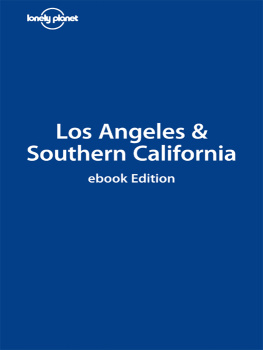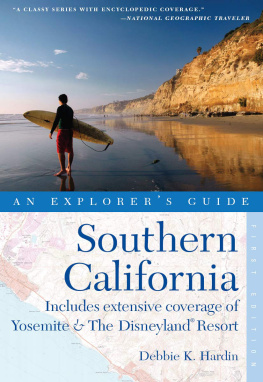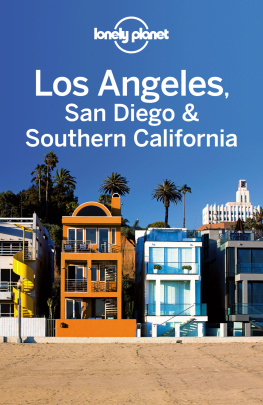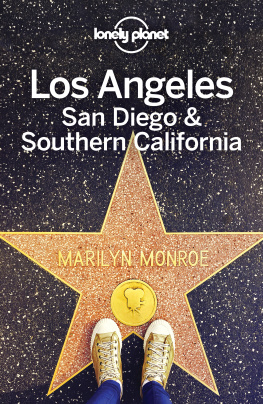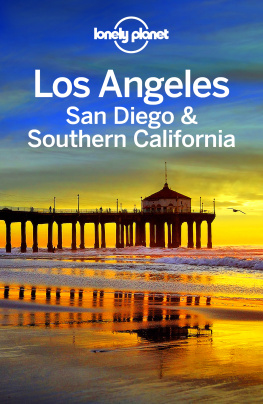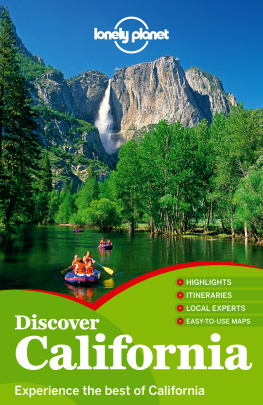Destination Los Angeles & Southern California
You might have a great number of expectations about what youll discover when you arrive in sunny Southern California. Surf, endless fun and sun, youth culture inventing itself before your eyes, and the legends of Hollywood and the Old West surrounding you everywhere. And they are all here. But just for a moment, let us give you a slightly different take on the mythology of Los Angeles and Southern California.
FAST FACTS
SoCal geographical size: 42,383 sq miles
SoCal population: 21,586,200
LA unemployment 2007: 5.1%
Number of movie studios in LA: 30
Life expectancy: women 81.8 years, men 77.1 years (two years more than nationwide)
Median price for a single-family home LA County: $593,000
SoCal contribution to GDP in 2006: $793.1 billion
Average rush-hour speed on LA freeways: 17mph
Average per capita income in LA County: $34,426
Number of annual passengers passing through LAX: 61 million (worlds fifth busiest airport)
Proportion of North American adult films made in SoCal: 85%
Theres a jutting outcrop of barren and heat-blasted rock high above Death Valley known as Aguereberry Point. The only way you can reach it is by taking the twisted and treacherous road wrenched and hewn in the 1930s by the eccentric prospector (Pete Aguereberry) after whom it is named. From here you can look out across 100 miles of one of the most desolate and forbidding landscapes on the planet and ask yourself, Why on earth would human beings ever risk their lives to cross this barren, hellish place? To the east youll spy the desolate mountains that pioneers just barely made it through; while to the west you will be able to make out towering mountains, their peaks covered with snow and the promise of life-giving water.
From this elevated viewpoint you can begin to imagine that even the slightest hope of what lay ahead was enough to keep early settlers alive for the last leg of their westward journey. If they did survive, their dreams would have been fulfilled. Among the wonders they found were alpine mountains soaring to over 10,000ft; coastal plains and beaches without equal; soil as rich as anywhere on earth, able to sustain livestock and produce wine, vast groves of fruit and fields of vegetables; and weather and sunlight thats the envy of all who live anywhere other than the Mediterranean. This was Southern California, the land of dreams and dreamers. And it is no less wondrous now.
Todays Southern California, or SoCal as its new natives call it, is the culmination of the efforts of generations of such dreamers. Bear in mind that on the pages that follow were talking about one half of a single American state. It has an economy roughly the equal of Spain. Its universities are plentiful and world class. From Los Angeles, the imagery spun by Hollywood dominates the digital transmissions and cultural trends of the entire planet. Surf, sand and sex will endure as long as there is a SoCal coast.
But SoCal is not a finished work. It remains one of the most dynamic places on earth in which to live and play. Just consider space probes, Disneyland, the internet, automotive and fashion design, the movie industry and its attendant media slaves all are headquartered in or managed from here. The regions growing pains have largely found an equilibrium. The problem now is growth itself.
The nightmares of the 90s the race riots and the catastrophic Northridge earthquake among them seem already to belong to a different age. But perhaps its because of this very adaptability and equanimity that SoCal has found that the human wave continues to crest and threaten. Every New Years Day, the largest commercial for living here the Rose Parade snares the imagination of folks freezing in Wisconsin or struggling to make ends meet in the American rust belt. Many of them choose to move here. With this burgeoning humanity come the attendant problems of horrific traffic and skyrocketing costs of living and real estate. Public transport is woefully inadequate, so everyone hits the freeway where average rush hour speed is a whopping 17mph. Sheer human impaction is a palpable force and begs the question that Rodney King so famously asked: Cant we all get along?
The current mayor of Los Angeles Antonio Villaraigosa, himself of Mexican descent is a fellow with bold ideas about social initiatives and its extremely difficult to envision a return to the infamous Zoot Suit Riots of the 40s or the uproar that followed the all-white jury verdict in the Rodney King beating case. You may be astonished to see the ethnic and racial mix of colleagues and friends walking along boulevards and beaches or gathering for meals together in SoCals plethora of world cuisine restaurants. As we joke locally, Whatever happens in SoCal today will happen to the rest of the world a few years later. We can only hope that, in terms of race and ethnic relations, this timetable speeds up enormously. Time and again, SoCal has proven itself to be resourceful, resilient, adaptive and innovative. With global warming threatening, you can bet the bank that Caltech, UCLA and other universities are directing their brains toward solving the issues.
The myths surrounding SoCal have somehow come true. You truly can surf in the morning in pleasant climes, spend the afternoon skiing down alpine slopes and end the day with alfresco dinner in the desert. Who wouldnt want to live here, even with the horrifying commuting times? Who wouldnt want to visit, or perhaps become a part of, one of the worlds greatest and most successful natural and social experiments?
Getting Started
Southern California (SoCal) has excellent tourism infrastructure, and backpackers, families and urban nomads will all find their needs and expectations met. Room and travel reservations are a good idea between June and early September and around major holidays, but otherwise you can keep your advance planning to a minimum. Traffic in the heavily congested coastal areas can be a nightmare at times. Avoid traveling between 3pm and 7pm on weekdays or, in the spirit of slow travel, consider using alternative transportation such as the train or bus for at least part of your trip.
WHEN TO GO
SoCals a great destination year-round, but most people visit in July and August when cloudless skies and high temperatures are pretty much guaranteed. This is the best time for frolicking on the beach, enjoying alfresco dinners and attending festivals and other open-air events. The mountains are gorgeous, especially if youre into hiking, biking or other outdoor pursuits. Summer is not ideal for exploring the desert, where the mercury can soar as high as 120F. In all areas the desert lodging is scarce and costly during these months and youll be jostling for space at major attractions. Note that in June thick clouds often blanket the beach towns, but by July the coast is usually clear, so to speak.
See Climate Charts for more information.
The shoulder seasons (March to May and September to November) bring smaller crowds, lower prices and more temperate weather. In spring wildflowers often brighten meadows, mountains and deserts, while in fall it can still be warm enough to swim in the Pacific.
Unless youre planning a beach vacation, winter (December to February) is a great time to visit, despite the greater chance of rain. Its ideal for exploring the desert, when temperatures are mild and pleasant. The mountains, meanwhile, have turned into a winter wonderland, drawing skiers and boarders to the slopes. City cultural calendars are in full swing, skies usually clear, temperatures still agreeable and lines as short as theyll ever be (except around holidays).

